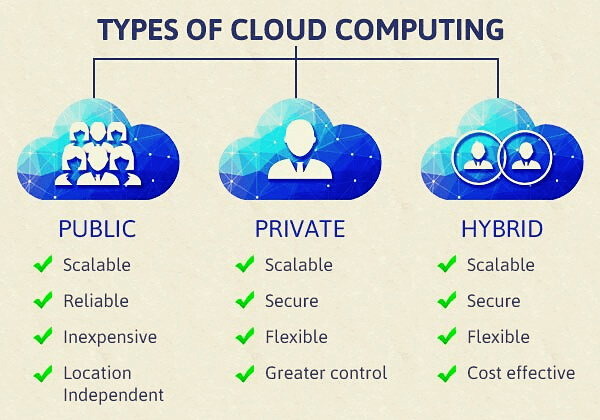What is Cloud Computing and its Types?

What is cloud computing and its types?
In short, cloud computing and its types are the provision of computing services (including servers, storage, databases, networks, software, analysis, and intelligence)-through the Internet to provide rapid innovation, flexible resources, and economies of scale. For cloud services, generally, you only need to spend as much as you need for resource consumption. This can help you reduce operating costs, make infrastructure operations more efficient, and adjust service usage according to changes in business needs.
Cloud computing and its types’ advantages
Cost advantage
Putting resources in a virtual resource pool for unified management optimizes physical resources to a certain extent. Users no longer need expensive hosts with large storage space. They can choose relatively cheap PCs to form a cloud, which reduces costs on the one hand and compute performance on the other. Not inferior to the mainframe. Cloud computing eliminates the need to invest in hardware and software, build and operate on-site data centers (including server racks, uninterruptible power supplies and cooling, and IT experts who manage infrastructure). Also increased the speed.
Speed advantage
Most cloud computing services are self-service on-demand, so a large number of computing resources can be deployed in a few minutes with a few mouse clicks, giving enterprises great flexibility and reducing the pressure of capacity planning.
Expansion advantage
Users can use the rapid deployment conditions of application software to more simply and quickly expand the existing and new services they need. Cloud computing has high-efficiency computing capabilities. Adding cloud computing functions to the original server can quickly increase the computing speed, and finally, realize the dynamic expansion of the level of virtualization to achieve the purpose of application expansion.
Efficiency advantage
The cloud computing platform can quickly allocate computing power and resources according to the needs of users. Cloud computing is highly compatible, not only compatible with low-configuration machines and hardware products from different manufacturers, but also with peripherals to obtain higher-performance computing.
Performance advantage
The virtualization technology of cloud computing includes application virtualization and resource virtualization, which breaks the boundaries of time and space. Cloud computing’s secure data center has more benefits than a single enterprise data center, including reduced application network latency and increased economies of scale.
Reliability advantage
Because data can be mirrored on multiple redundant sites in the cloud provider’s network, cloud computing can simplify data backup, disaster recovery, and low-cost business continuity. Because the single point server fails, the applications distributed on different physical servers can be restored through virtualization technology or the dynamic expansion function can be used to deploy new servers for calculation. If the server fails, it will not affect the normal operation of computing and applications.
Security advantage
Many cloud vendors provide a large number of strategies, technologies, and controls to improve the overall security situation to help protect data, applications, and infrastructure from potential threats.
Cloud Computing and its types

There are certain differences between cloud and cloud, not to say that one kind of cloud computing is suitable for all people. Services of cloud computing and its types will be implemented according to the type of cloud development or cloud computing infrastructure. There are three ways to deploy cloud computing: public cloud, private cloud, and hybrid cloud.
Public cloud: In general, a public cloud is a cloud provided to users by a third-party provider. It can be used on the Internet. It can be free or cheap. Its core attribute is shared resource services.
Private Clouds: Private Clouds are worked for a single customer to use, thus providing the most effective control over data, security, and service quality. The company owns the infrastructure and can control how applications are deployed on this infrastructure. The core attribute of private clouds is proprietary resources. Private clouds can be deployed in the firewall of an enterprise data center, or they can be deployed in a secure hosting location.
Hybrid cloud: Hybrid cloud integrates public cloud and private cloud, and is the main model and development direction of cloud computing in recent years. We already know that private clouds are mainly for corporate users. For security reasons, companies are more willing to store data in private clouds, but at the same time, they hope to obtain computing resources from public clouds. In this case, hybrid clouds are becoming more and more popular. With more adoption, it mixes and matches public clouds and private clouds to get the best results. This personalized solution achieves the goal of saving money and security.
Learn Technical Cyber Strategy For Securing Cloud Based Services And Infrastructure. Read More.






